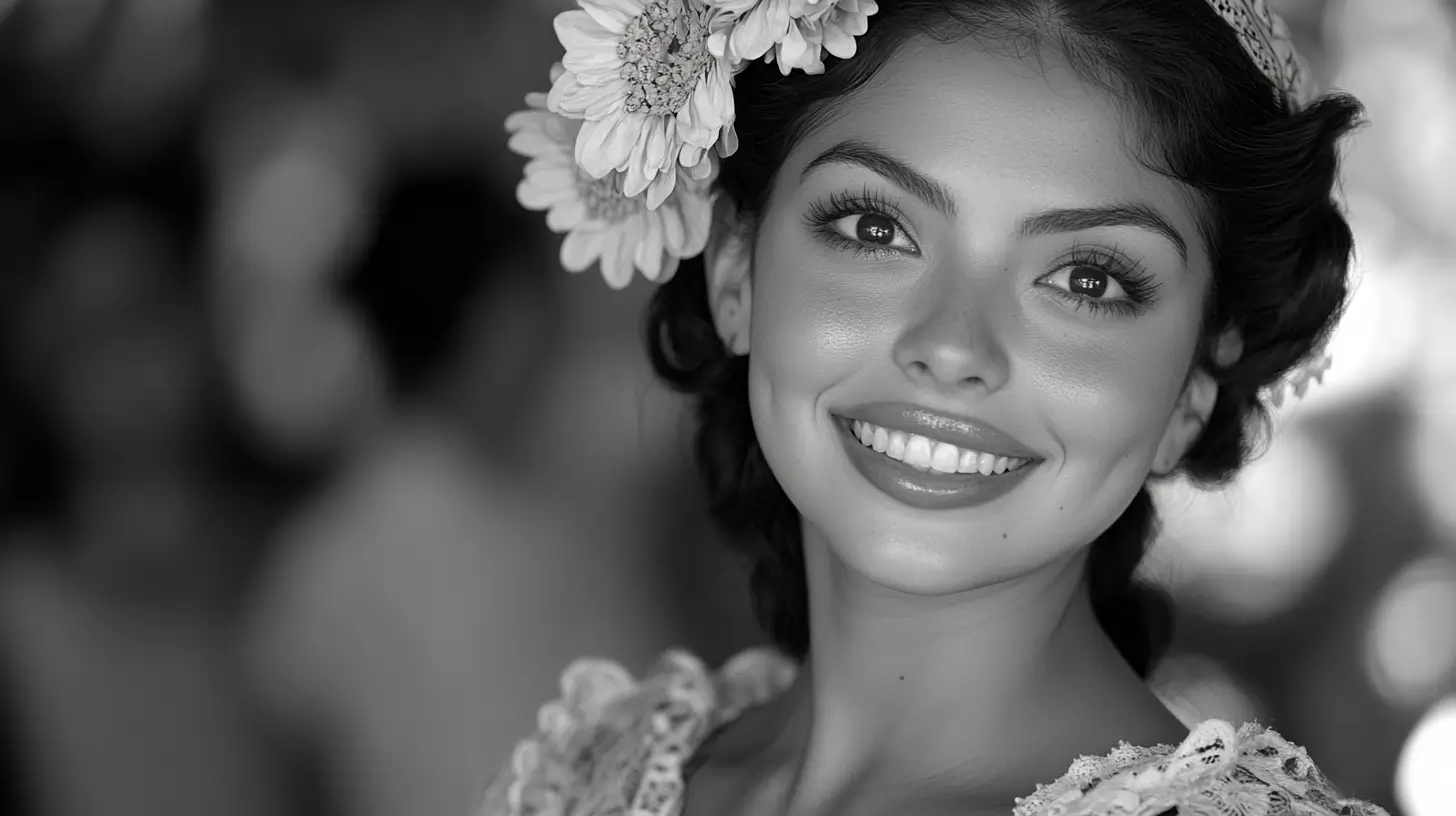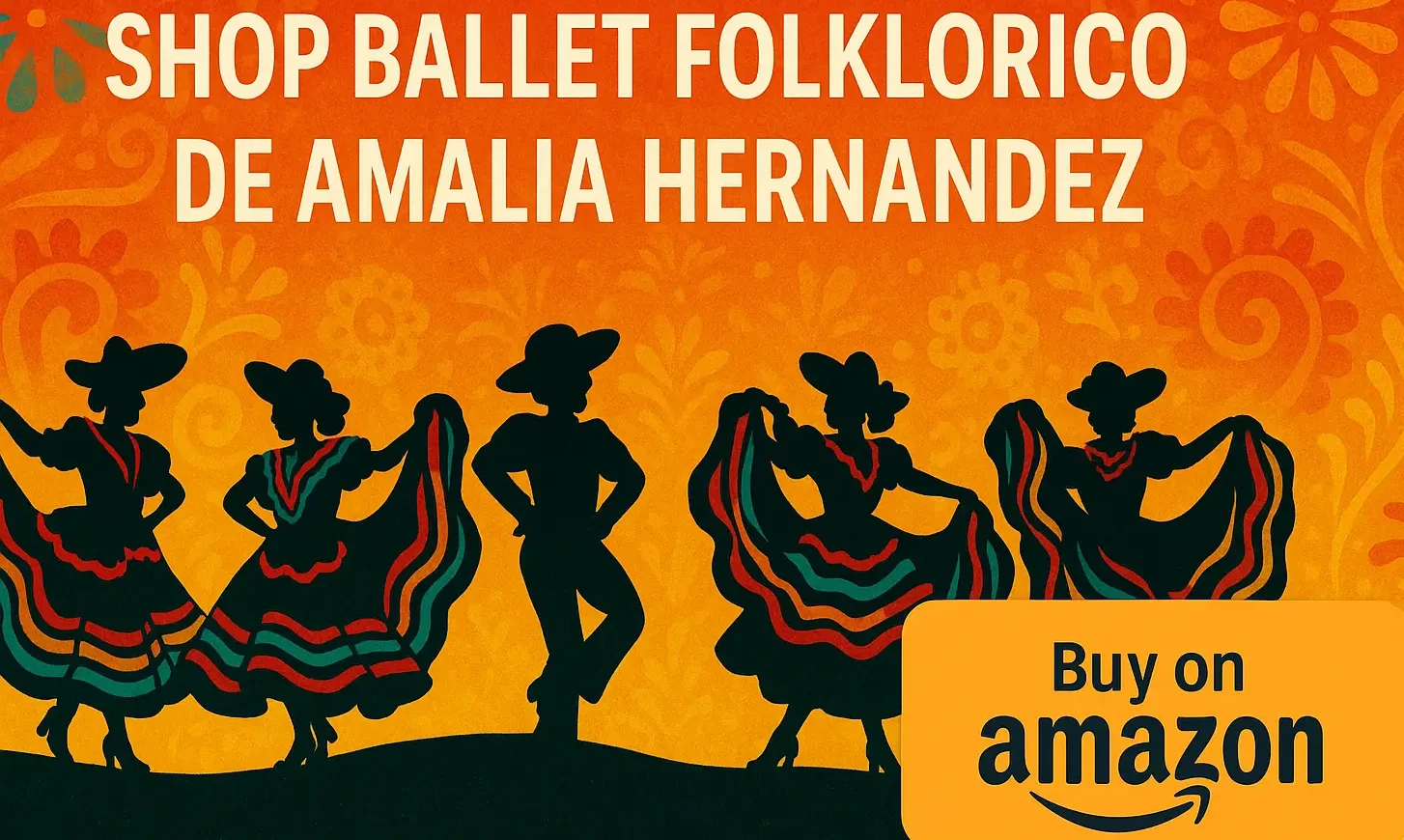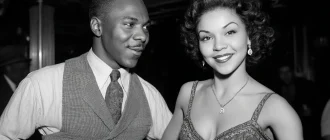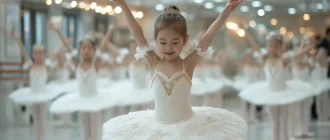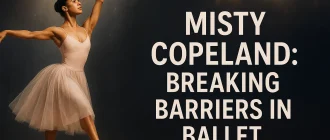Ballet folklórico de Amalia Hernández captivates audiences with its stunning dance performances celebrating Mexican culture. Ballet folklórico brings together the rich tapestry of Mexican culture through its vibrant music, dance, and costumes, which reflect traditional folklore from pre-Columbian times to the present. Founded in 1952 by Amalia Hernández, this ensemble brings Mexican traditions to life on stage. Discover its rich history and cultural impact, and find out where you can see Ballet Folklórico de Amalia Hernández perform next.
Graceful Insights
- Ballet Folklórico de México, founded by Amalia Hernández in 1952, preserves and celebrates Mexican cultural traditions through vibrant dance, music, and costumes. It showcases over 40 ballets that reflect the country’s diverse heritage.
- The company successfully adapts traditional Mexican dance for contemporary audiences, integrating modern choreography and artistic expressions while performing at historic venues worldwide, including the iconic Palacio de Bellas Artes.
- Ballet Folklórico de México fosters a deep cultural pride among local and international audiences. Through captivating performances and elaborate storytelling, it enhances global appreciation for Mexican folklore.
Art de Podcast
| Feature | Details |
|---|---|
| Name | Ballet Folklórico de México de Amalia Hernández |
| Founder | Amalia Hernández Navarro |
| Established | 1952 |
| Location | Mexico City, Mexico |
| Dance Genre | Traditional Mexican folk dance |
| Performance Venue | Palacio de Bellas Artes (Mexico City) |
| Artistic Director | Salvador López López (current) |
| Key Styles & Dances | Jarabe Tapatío, Danza del Venado, Veracruz sones, Danza de los Quetzales, regional Mexican dances |
| Signature Feature | Vibrant costumes, live traditional music, dynamic choreography, and cultural storytelling. |
| Notable Achievements | Over 100 international tours, performances in more than 60 countries, and prestigious awards, including the National Arts Award (Premio Nacional de Artes, Mexico) |
| Educational Contributions | Dance workshops, training schools, and cultural preservation efforts |
| Audience Appeal | Family-friendly, cultural heritage enthusiasts, international tourists, and students |
| Official Website | www.balletfolkloricodemexico.com.mx |
Ballet Folklórico de México de Amalia Hernández: A Cultural Treasure
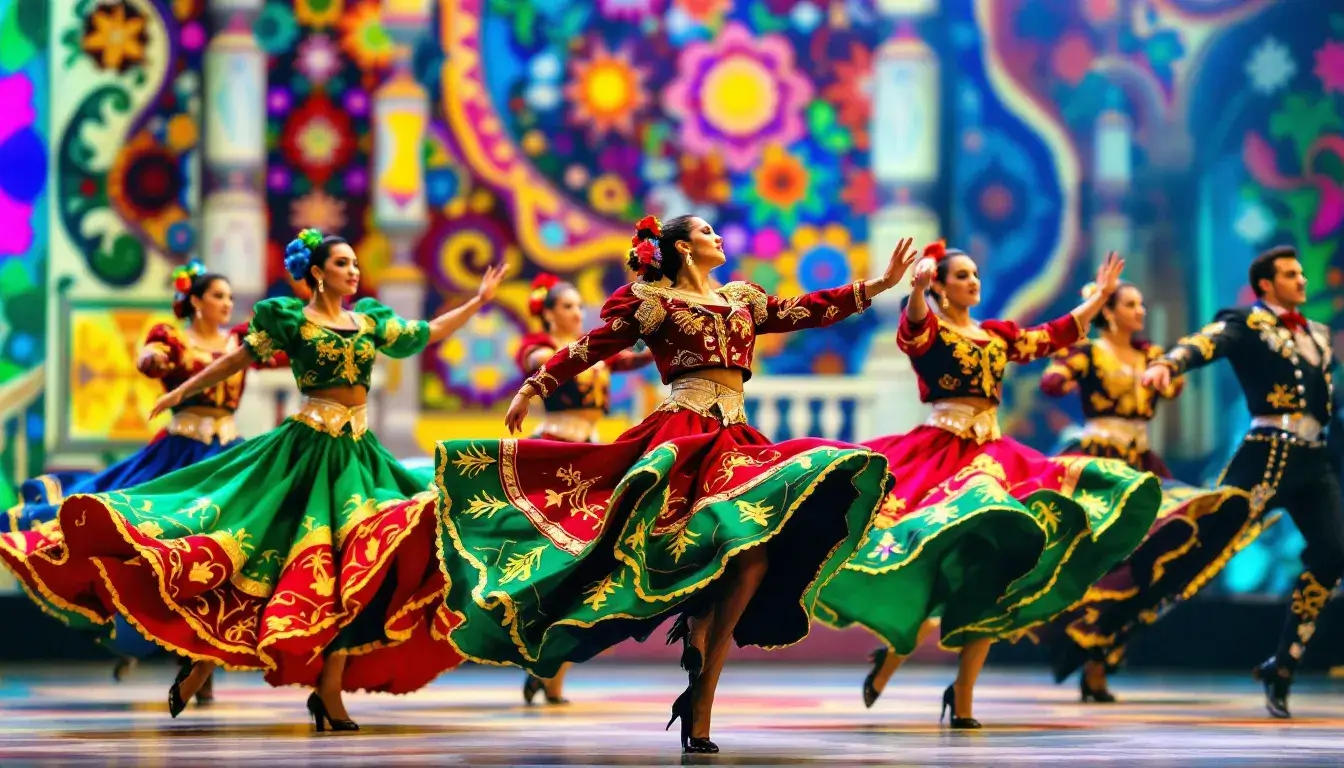
Ballet Folklórico de México de Amalia Hernández stands as a monumental cultural treasure, preserving the essence of Mexican folklore through dance, music, and costume. Founded in 1952 by the illustrious Amalia Hernández, this ensemble has grown into a renowned institution that captures the heart and soul of Mexican traditions. With a company comprising 60 folk dancers and musicians, Ballet Folklórico de México has developed over 40 ballets, each a testament to the country’s rich and diverse cultural heritage. Ballet Folklórico de México has performed extensively both within Mexico and internationally.
Ballet Folklórico de México’s mission extends beyond performance, a crucial medium for preserving and celebrating traditional Mexican customs and heritage. The ensemble’s meticulously crafted performances highlight the multifaceted traditions and customs that define Mexican culture. Amalia Hernández’s work profoundly reshapes perceptions of Mexican cultural identity nationally and internationally. Her approach to transforming folk traditions into accessible and appealing forms for modern audiences has significantly influenced Mexico’s identity on a global scale, showcasing traditional dances often of great technical difficulty.
Performing regularly at historic venues like the Palacio de Bellas Artes, Ballet Folklórico de México continues to enchant audiences with its vibrant and dynamic performances. Each show is a journey through time, bringing to life the stories and legends of Mexican folklore from pre-Columbian civilizations to contemporary celebrations. Hernández’s artistic legacy continues to inspire and captivate, making Ballet Folklórico de México a true cultural ambassador of Mexican heritage.
The Vision of Amalia Hernández
Amalia Hernández was a visionary whose passion for Mexico’s cultural diversity led her to create an ensemble representing the country’s rich heritage through dance. Inspired by various regions’ myriad traditions, customs, and folklore, Hernández aimed to highlight Mexico’s diverse cultural heritage through traditional dances. Her vision was to preserve these traditions and bring them to life in a way that resonated with contemporary audiences.
Under her direction, Ballet Folklórico de México became a living canvas, painting vivid pictures of Mexico’s past and present. Hernández’s dedication to showcasing the beauty and complexity of Mexican culture through dance has left an indelible mark on the arts. Hernández’s artistic legacy’s ability to blend traditional and modern elements seamlessly has created a timeless appeal, ensuring that her artistic legacy continues to inspire and educate future generations about the richness of Mexican folklore.
Evolution Over the Years
Since its inception, Ballet Folklórico de México has evolved, adapting its performances to include modern artistic expressions while remaining true to its roots in Mexican folklore. Over the decades, the company has incorporated new choreography and innovative elements, ensuring that each performance remains fresh and engaging for audiences of all ages.
This evolution has allowed Ballet Folklórico de México to stay relevant in the modern era, continuously drawing in new audiences while maintaining the essence of traditional Mexican dance. The incorporation of contemporary influences alongside historical narratives creates a dynamic and immersive experience, showcasing the timeless beauty of Mexican culture through a modern lens.
As a result, the company has managed to preserve its cultural heritage while embracing present-day artistic possibilities.
Upcoming Performances
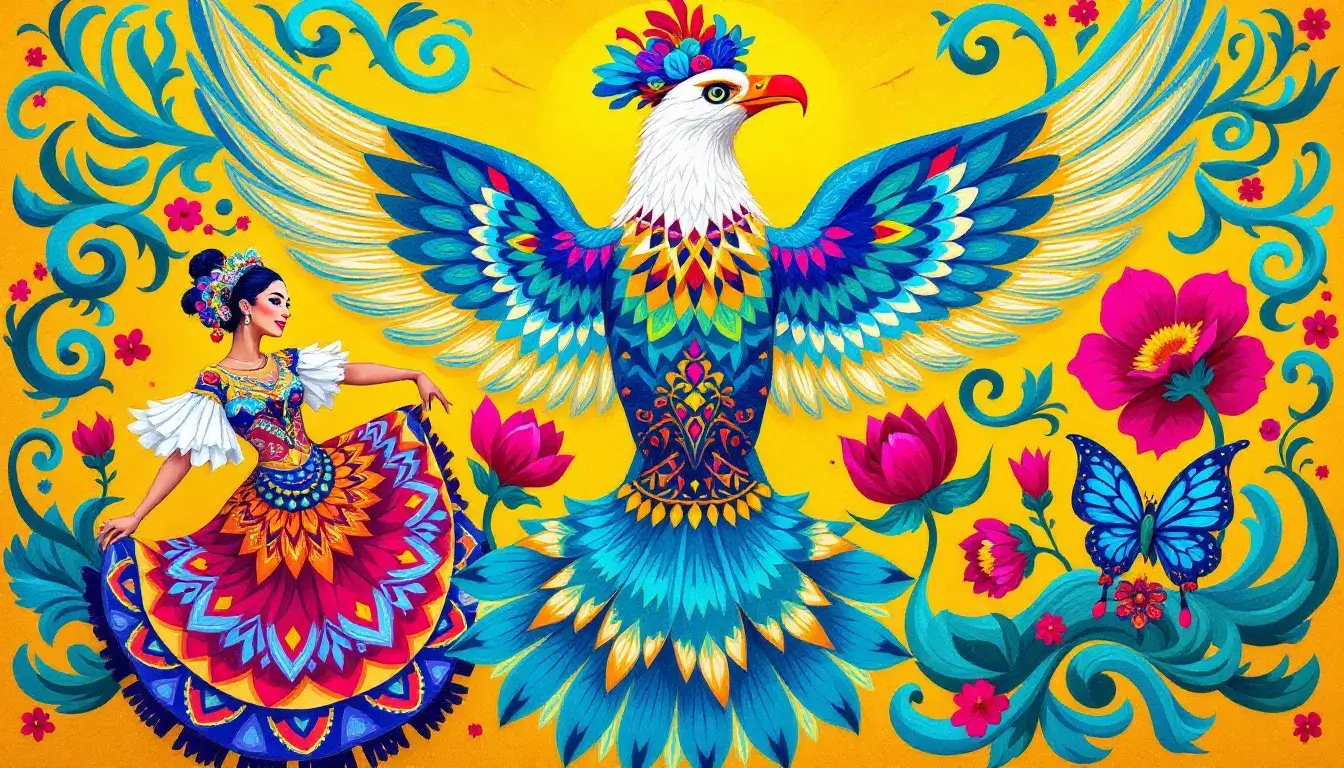
For those eager to witness the magic of Ballet Folklórico de México firsthand, several upcoming performances are scheduled in various locations. Whether in the United States or globally, these shows promise to display Mexican culture and tradition. On March 16, 2025, the ensemble will perform at the Luckman Fine Arts Complex in Los Angeles, California, followed by a show at the Balboa Theatre in San Diego on March 23, 2025.
These performances offer a unique opportunity to experience the enchantment of Ballet Folklórico de México in person. Ballet Folklórico de México highlights Mexico City’s rich cultural and historical significance through its Palacio de Bellas Artes performances. Each show meticulously presents traditional dances, elaborate costumes, and world-class choreography that brings the rich tapestry of Mexican folklore to life. Don’t miss the chance to be part of this cultural celebration.
United States Tour Dates
In March 2025, Ballet Folklórico de México will tour major U.S. cities, bringing their captivating performances to American audiences. The tour starts in Los Angeles, where the troupe will perform two shows on March 16, 2025, at 3:00 PM and 7:00 PM at the Luckman Fine Arts Complex. These performances promise to showcase Mexican folklore spectacularly, featuring intricate choreography and vibrant costumes.
Following its Los Angeles shows, the company will perform at the Balboa Theatre in San Diego on March 23, 2025, at 7:00 PM. San Diego audiences can look forward to an enchanting evening of dance and music celebrating Mexico’s rich cultural heritage.
These tour dates are a testament to the enduring appeal and international acclaim of Ballet Folklórico de México.
International Shows
Ballet Folklórico de México is not confined to performances within Mexico and the United States; the company has gained international acclaim, showcasing Mexican folklore to audiences worldwide. Their performances abroad have introduced global audiences to Mexico’s rich cultural narratives. Performing in various countries has significantly bolstered Mexico’s cultural presence worldwide.
Their extensive international tour schedule demonstrates the troupe’s global commitment to sharing Mexican music and folklore. Historic venues worldwide have hosted their performances, allowing audiences from different cultures to experience Mexico’s vibrant traditions. This international recognition highlights the artistic excellence of Ballet Folklórico de México and fosters cultural exchange and appreciation.
The Magic of Ballet Folklórico Performances
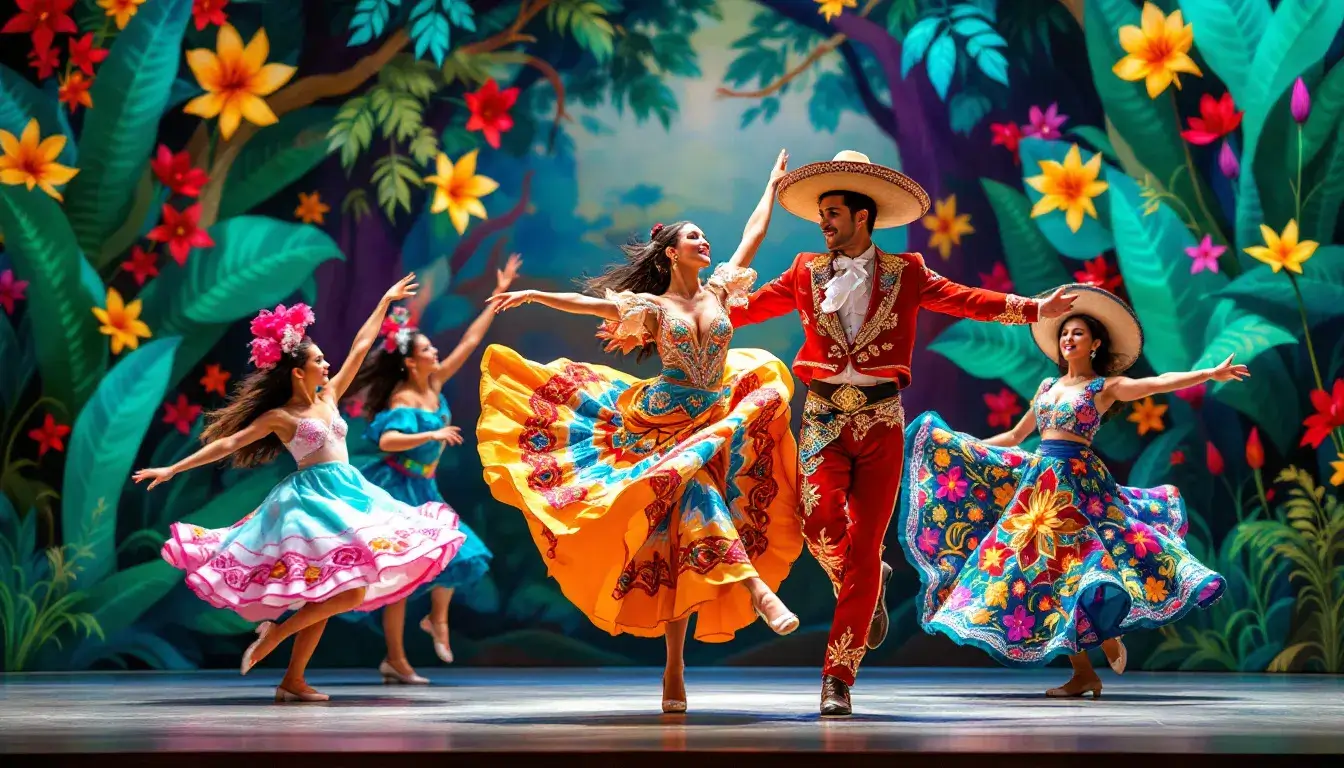
There is a certain magic that envelops every performance of Ballet Folklórico de México. From the moment the curtain rises, audiences are transported into a world of vibrant colors, rhythmic music, and intricate dance movements. The company’s world-class dancers bring each performance to life with exceptional skill and passion, captivating audiences with every step.
The elaborate costumes worn by the dancers add to the visual splendor of the performances. Each costume is a work of art, representing different Mexican regions’ unique cultural identity and history. The vibrant colors and intricate designs are visually stunning and deeply symbolic, reflecting Mexico’s rich heritage.
Exquisite choreography, blending traditional and classical dance styles, lies at the heart of every Ballet Folklórico de México performance. The choreography tells stories of Mexico’s past, weaving together elements from indigenous and colonial dance traditions. This fusion of styles creates a unique and unforgettable dance experience that resonates with audiences long after the dancer bows.
World-Class Dancers
The dancers of Ballet Folklórico de México are truly world-class. They undergo rigorous training to master the technical aspects of their performances. Each former dancer and choreographer brings a deep understanding of traditional Mexican dance and the technical expertise required for complex choreography. This dedication and passion are evident in every performance, captivating audiences gracefully and precisely.
The choreography often incorporates storytelling elements, using expressive gestures and movements to convey historical and cultural narratives. This storytelling aspect adds depth to the performances, connecting audiences with Mexico’s rich history and traditions. The result is a captivating and immersive experience that leaves a lasting impression on all who witness it.
Elaborate Costumes
One of the most striking aspects of Ballet Folklórico de México performances is the elaborate costumes worn by the dancers. These costumes are designed to reflect the cultural heritage of various Mexican regions, showcasing the diversity and richness of Mexican traditions. Each costume vibrantly represents the unique identity and history of the area it represents.
The vibrant colors and intricate designs of the costumes add a visual feast to the performances, enhancing the overall aesthetic appeal. Audience members frequently highlight the costumes as a significant aspect of the show, noting how they contribute to the storytelling and cultural richness of the performances.
The attention to detail in the costumes and choreography is a testament to the dedication and artistry of Ballet Folklórico de México.
Exquisite Choreography
Amalia Hernández’s vision for Ballet Folklórico de México included a unique blend of traditional Mexican and classical ballet styles. This fusion of styles is evident in the exquisite choreography that characterizes the company’s performances. Each dance is a carefully crafted piece that showcases Mexico’s rich cultural heritage through movement.
The choreography incorporates various techniques influenced by indigenous and colonial dance traditions, creating a dynamic and engaging performance. Audience feedback often highlights the impressively developed choreography as one of the show’s key highlights, with many viewers praising the seamless blend of traditional and modern elements. This exquisite choreography is a testament to the artistic vision and dedication of Ballet Folklórico de México.
Audience Reviews and Reactions
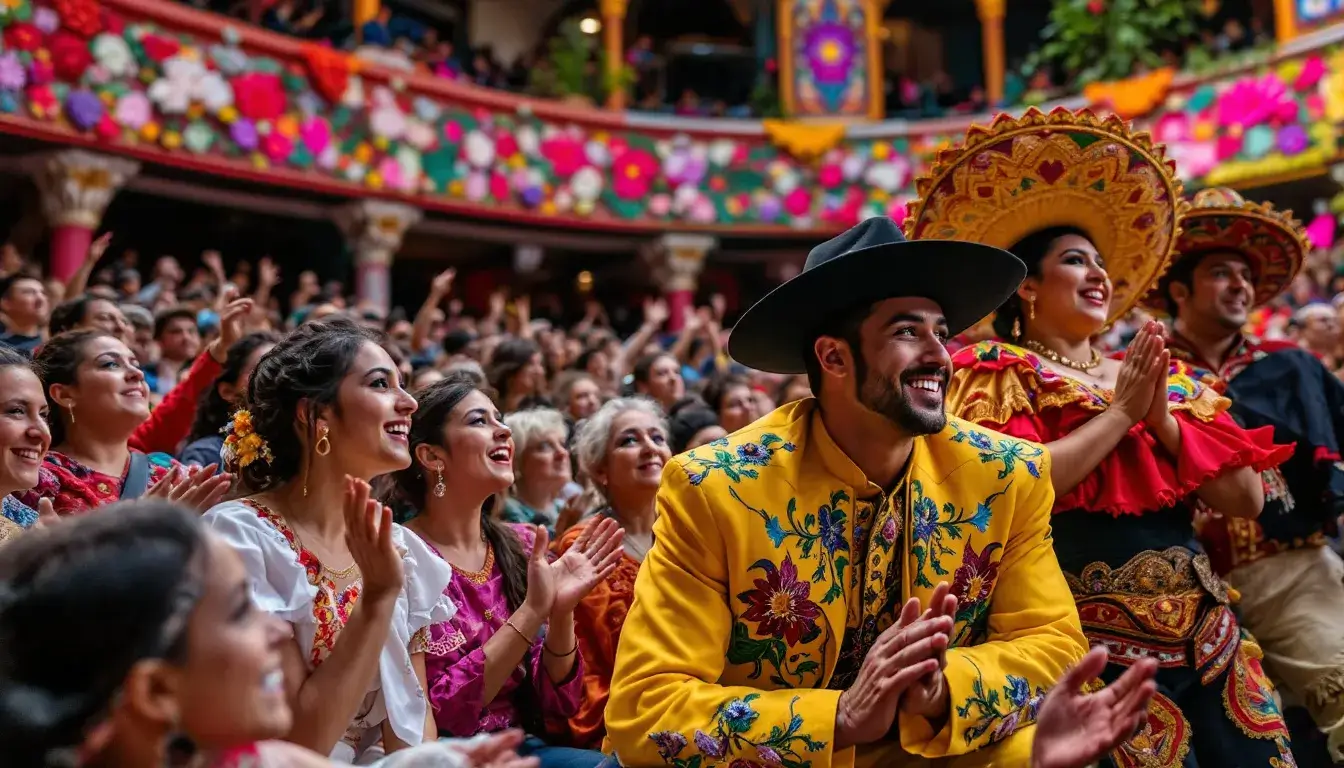
The performances of Ballet Folklórico de México leave a lasting impression on audiences, who often describe their experiences using words like “breathtaking,” “amazing,” “beautiful,” and “colorful.” Many viewers express overwhelming enjoyment and emotional resonance, finding the shows a significant cultural experience that leaves lasting memories.
Audience members frequently praise the performances’ beautiful costumes, great dances, and high energy, noting how these elements create a nostalgic experience that connects them to Mexico’s rich heritage. The passion and pride of Mexican culture shine through in every performance, making Ballet Folklórico de México a beloved and unforgettable experience for all who attend.
Unforgettable Experience
Audience members often describe Ballet Folklórico de México performances as captivating and mesmerizing. The colorful costumes and dynamic choreography create a visual and emotional spectacle that resonates deeply with viewers. One audience member, Rebecca, found the show particularly enchanting, describing it as a mesmerizing experience that exceeded her expectations.
Vibrant costumes and engaging performances frequently evoke nostalgia and pride in Mexican heritage. Audience members often highlight how the shows remind them of their cultural roots, creating a profound connection to their heritage. This emotional resonance is a testament to Ballet Folklórico de México’s power to inspire and captivate audiences.
Cultural Pride
The shows of Ballet Folklórico de México inspire a deep sense of pride in Mexican heritage, celebrating cultural identity through dance. Testimonials from audience members often express a profound appreciation for the vibrant celebration of Mexican culture, highlighting how the performances create unforgettable experiences that resonate with their cultural identity.
Ballet Folklórico de México significantly promotes and preserves Mexican culture, inspiring audiences to take pride in their heritage. The passionate and energetic performances showcase Mexico’s rich traditions and customs, creating a sense of cultural pride that stays with audiences long after the show has ended.
The Legacy of Amalia Hernández
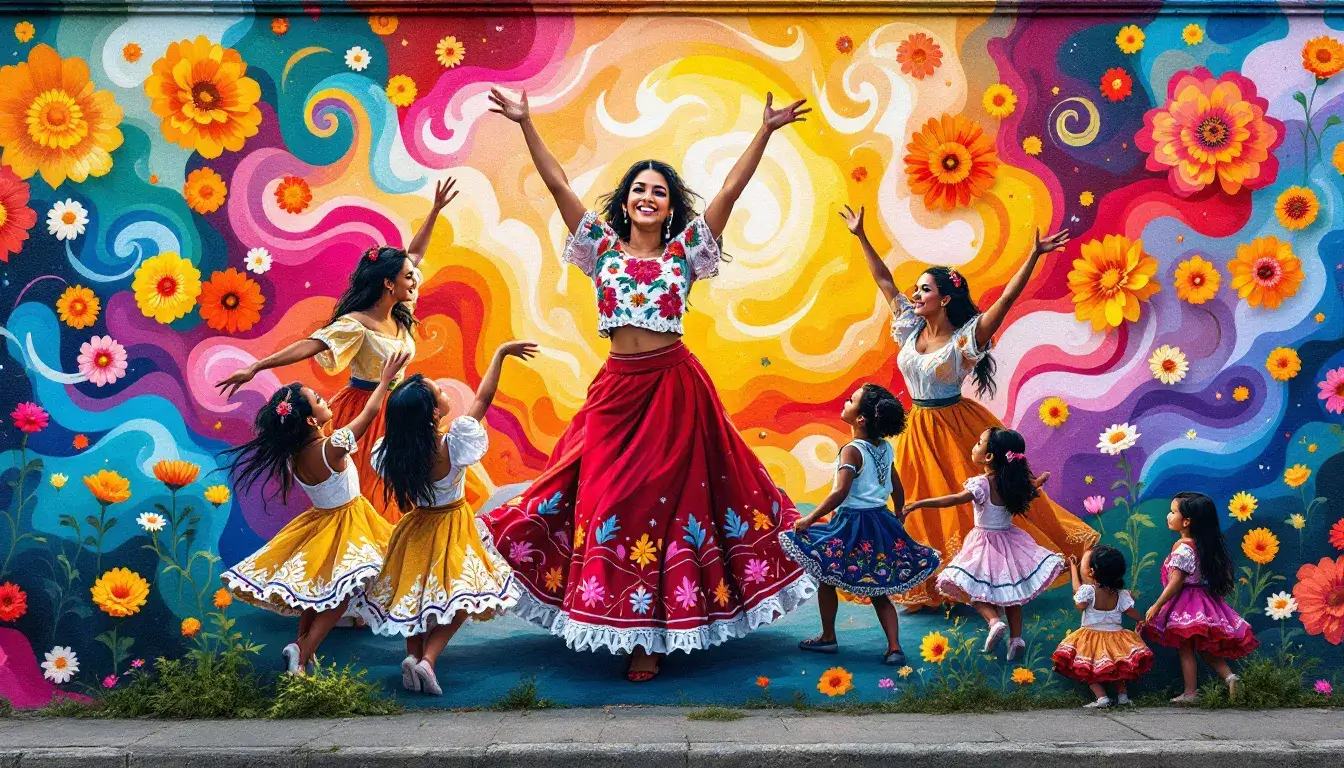
The legacy of Amalia Hernández has a profound impact and lasting influence. Through her visionary work, de Amalia Hernández has left an indelible mark on the world of dance and Mexican culture.
Ballet Folklórico de México is a cultural ambassador, showcasing Mexico’s multi-layered history through its performances. This expression of Mexican culture through dance is a testament to Hernández’s dedication and artistic vision, which continues to inspire and captivate audiences worldwide.
Impact on Mexican Culture
Amalia hernández ballet. Hernández’s choreography celebrates the rich heritage of Mexican culture by incorporating elements from pre-Colombian civilizations and historical influences. This blend of ancient and modern traditions connects to Mexico’s past, instilling audiences with a deep sense of pride. Many reviewers say that watching the performances makes them feel a profound connection to their roots, as they celebrate their heritage through the artistic representations on stage, showcasing the work of choreographer Amalia Hernández.
The sense of cultural pride is further amplified by the 40 distinct ballets that Ballet Folklórico de México developed. Each performance is a tribute to Mexico’s diverse and vibrant culture, showcasing its richness in traditions and customs. Through these artistic expressions, the company plays a crucial role in preserving and celebrating Mexican culture while inspiring national and international audiences.
Global Influence
Ballet Folklórico de México’s influence extends far beyond Mexico’s borders. The company has gained international recognition and acclaim for its performances, which have introduced Mexican folklore to global audiences and significantly enhanced cultural exchange and appreciation. By performing in prestigious theaters across Europe and North America, Ballet Folklórico de México has elevated the visibility of Mexican arts on the world stage.
These international performances often include collaborations with renowned artists and groups, further enriching the cultural experience. The company’s ability to blend traditional Mexican dance with contemporary artistic expressions has made it a beloved and respected institution worldwide.
Through these collaborations and performances, Ballet Folklórico de México continues to foster a deeper understanding and appreciation of Mexican culture among global audiences.
Historic Venues and Special Engagements
Ballet Folklórico de México’s shows are more meaningful when performed at historic venues celebrating the company’s artistic and cultural identity. One of the most iconic venues is the Palacio de Bellas Artes in Mexico City, where the company has performed numerous times since its establishment.
This stunning venue, renowned for its architectural beauty and cultural significance, is the perfect backdrop for the vibrant performances that showcase Mexico City’s traditional Mexican folk culture.
Palacio de Bellas Artes
The Palacio de Bellas Artes is not just a venue, but a national treasure that holds a special place in the history of Ballet Folklórico de México. Located in the heart of Mexico City, this iconic theater hosts the company’s performances twice a week. Audiences regularly experience the magic of traditional Mexican dances accompanied by live music. The venue’s cultural significance and stunning architecture make it an ideal setting for the company’s captivating shows.
In 2025, the company will perform at the Palacio de Bellas Artes on several dates, starting from February 26, with additional shows on March 2, March 5, and March 9. These performances are a testament to the enduring appeal and cultural importance of Ballet Folklórico de México, continuing to draw audiences to this historic venue.
Each show at the Palacio de Bellas Artes is a celebration of Mexican heritage and a tribute to Amalia Hernández’s artistic vision.
Other Renowned Theaters
Beyond the Palacio de Bellas Artes, Ballet Folklórico de México has performed extensively in various historic theaters worldwide, enhancing its global presence and recognition. These performances in prestigious venues across Europe and North America have solidified the company’s reputation as a leading cultural ambassador of Mexican folklore. Each historic venue adds a unique charm and significance to the performances, creating unforgettable experiences for the audience.
Ballet Folklórico de México continues to celebrate and promote Mexican culture internationally by showcasing its art in these renowned theaters. The company’s ability to captivate audiences in historic venues worldwide is a testament to their performances’ universal appeal and artistic excellence.
Through these special engagements, Ballet Folklórico de México fosters cultural exchange and appreciation, bringing the beauty of Mexican folklore to a global audience.
Resume
Ballet Folklórico de México, led by Amalia Hernández, is a beacon of cultural preservation and artistic excellence. Through mesmerizing performances, it celebrates the rich traditions of Mexican folklore. From its inception in 1952 under the visionary Amalia Hernández to its evolution into a globally recognized institution, the company has remained dedicated to showcasing Mexico’s diverse cultural heritage. With elaborate costumes, world-class dancers, and exquisite choreography, each performance is a vibrant tribute to the country’s history and traditions.
As the company continues to captivate audiences in historic venues and on international stages, Amalia Hernández’s legacy lives on, inspiring pride in Mexican heritage and fostering cultural exchange. Whether performing at the iconic Palacio de Bellas Artes or prestigious theaters worldwide, Ballet Folklórico de México brings the magic of Mexican folklore to life, creating unforgettable experiences for audiences everywhere. Don’t miss the opportunity to witness this cultural treasure and be part of the enchanting journey through Mexico’s rich artistic heritage.
Frequently Asked Questions
When was Ballet Folklórico de México founded?
Ballet Folklórico de México was founded in 1952 by Amalia Hernández.
Where can I see Ballet Folklórico de México perform in 2025?
You can view Ballet Folklórico de México at the Palacio de Bellas Artes in Mexico City in 2025, in the United States in Los Angeles on March 16, and in San Diego on March 23.
What makes Ballet Folklórico de México’s performances unique?
Ballet Folklórico de México’s performances are unique because they fuse traditional Mexican dance with classical ballet techniques, incorporate vibrant regional costumes, and employ storytelling elements to convey rich historical and cultural narratives.
How has Ballet Folklórico de México contributed to preserving Mexican culture?
Ballet Folklórico de México has significantly contributed to preserving Mexican culture by showcasing traditional dances, music, and costumes representing the nation’s diverse heritage. Their performances act as cultural ambassadors, emphasizing Mexican traditions and customs richness.
What is the significance of the Palacio de Bellas Artes for Ballet Folklórico de México?
The Palacio de Bellas Artes is significant for Ballet Folklórico de México as a prestigious venue for their performances, showcasing the company’s cultural artistry in an iconic and architecturally stunning environment. The theater’s historic importance enhances the overall experience of their shows.
Who was Amalia Hernández Navarro, and what inspired her to create Ballet Folklórico de México?
Amalia Hernández Navarro (1917–2000) was a Mexican choreographer who, dissatisfied with modern and European dance forms, turned to traditional Mexican folk dances. Drawing on her childhood training in art, music, and dance, she founded Ballet Folklórico de México 1952 with eight performers, pioneering a new theatrical expression of Mexico’s diverse regional cultures.
What is the Folkloric Ballet School founded by Amalia Hernández?
In 1968, Amalia Hernández established the Escuela de Ballet Folklórico in Mexico City to train dancers in folkloric techniques. The school’s building was designed by her brother, architect Agustín Hernández Navarro, and continues to offer professional-level courses and workshops in traditional Mexican dance.
How many choreographies did Amalia Hernández create during her career?
Throughout her nearly five-decade career, Amalia Hernández created more than 60 original choreographies, blending historical research with creative staging to revive and celebrate dances such as “Melodies of Michoacán” and the “Deer Dance.”
Who currently leads Ballet Folklórico de México, and what is their connection to Amalia Hernández?
After Amalia Hernández’s passing in 2000, her grandson Salvador López assumed artistic leadership of Ballet Folklórico de México, ensuring that her vision and methodologies continue to guide the company’s repertoire and training.
When and where does Ballet Folklórico de México perform regularly?
Since 1960, the company has held a resident engagement at the Palacio de Bellas Artes in Mexico City, presenting performances every Sunday morning and Wednesday evening to showcase its evolving repertoire to local and visiting audiences.
How extensive is the company’s international touring history?
Ballet Folklórico de México has completed over 100 international tours, appearing in more than 60 countries and 300 cities. It has given upwards of 15,000 performances, averaging around 250 shows per year, and reached audiences numbering in the tens of millions worldwide.
What major awards and recognitions has Ballet Folklórico de México received?
The company’s accolades include “Best Dance Group in the World” at the 1961 Festival of Nations in Paris, the Premio Roma (1969), Mexico’s National Arts and Sciences Award (1992), the Tiffany Award (1992), and honors from Fundación México Unido and the Lunas del Auditorio (2003), among others.
What musical instruments typically accompany Ballet Folklórico de México’s performances?
Performances are supported by live ensembles resembling traditional mariachi bands, featuring violins, trumpets, the deep-bodied guitarrón, the five-string vihuela, and the guitar, providing the vibrant rhythmic and melodic foundation for the choreography.
Are there educational or outreach programs associated with Ballet Folklórico de México?
Yes. Beyond its school in Mexico City, the company offers master classes, residencies, and workshops in venues around the world, partnering with cultural institutions and universities to teach folkloric dance techniques and the history behind them.
How can aspiring dancers audition for Ballet Folklórico de México?
Auditions are announced periodically on the company’s official website and social media channels. Interested professional-level dancers typically submit résumés, headshots, and short video clips via the online audition portal or by email to the company’s casting office.
What significance does Ballet Folklórico de México hold in preserving indigenous Mexican dance traditions?
The company conducted extensive field research to recover and adapt indigenous and mestizo dances—such as the Parachicos and the Deer Dance—bringing them to the stage and helping secure recognition of dances like Parachicos as Intangible Cultural Heritage.
How has Ballet Folklórico de México influenced global perceptions of Mexican culture?
As a cultural ambassador, the company represented Mexico at events like the 1959 Pan American Games and performed for heads of state and world leaders. It inspired a Google Doodle in 2017, shaping international understanding of Mexico’s artistic heritage.
What are some signature works or dances choreographed by Amalia Hernández?
Among her most celebrated pieces are “Sones de Michoacán” (Melodies of Michoacán), “Danza del Venado” (Deer Dance), “Jarabe Tapatío,” “Fandangos,” “Los Quetzales,” and “El Cupidito,” each spotlighting a particular region’s musical and cultural traditions.
Does the company offer performances in collaboration with other artistic institutions or orchestras?
Yes. Ballet Folklórico de México has collaborated with ensembles such as the Los Angeles Philharmonic under conductor Carlos Miguel Prieto and appeared in festivals and concert halls alongside symphony orchestras worldwide.
What documentary or media resources are available to learn about Ballet Folklórico de México and Amalia Hernández?
Documentary films include the 2000 TV mini-series “Amalia Hernández, El espectáculo de la danza,” a 1989 English-language video “Ballet Folklórico de México,” and numerous archival performance recordings available through cultural archives and public platforms.

